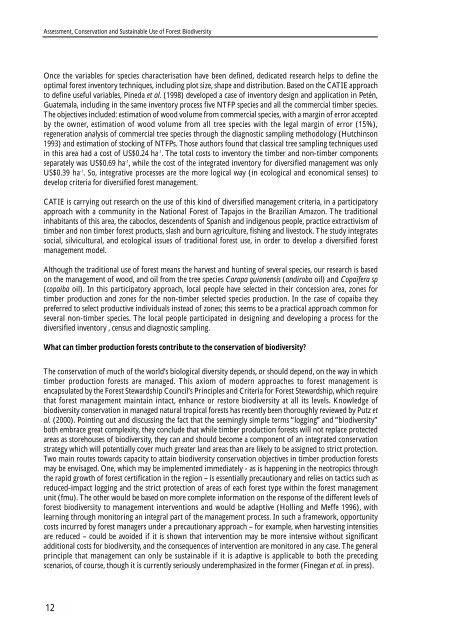Assessment, Conservation and Sustainable Use of Forest Biodiversity
Assessment, Conservation and Sustainable Use of Forest Biodiversity
Assessment, Conservation and Sustainable Use of Forest Biodiversity
Create successful ePaper yourself
Turn your PDF publications into a flip-book with our unique Google optimized e-Paper software.
<strong>Assessment</strong>, <strong>Conservation</strong> <strong>and</strong> <strong>Sustainable</strong> <strong>Use</strong> <strong>of</strong> <strong>Forest</strong> <strong>Biodiversity</strong><br />
Once the variables for species characterisation have been defined, dedicated research helps to define the<br />
optimal forest inventory techniques, including plot size, shape <strong>and</strong> distribution. Based on the CATIE approach<br />
to define useful variables, Pineda et al. (1998) developed a case <strong>of</strong> inventory design <strong>and</strong> application in Petén,<br />
Guatemala, including in the same inventory process five NTFP species <strong>and</strong> all the commercial timber species.<br />
The objectives included: estimation <strong>of</strong> wood volume from commercial species, with a margin <strong>of</strong> error accepted<br />
by the owner, estimation <strong>of</strong> wood volume from all tree species with the legal margin <strong>of</strong> error (15%),<br />
regeneration analysis <strong>of</strong> commercial tree species through the diagnostic sampling methodology (Hutchinson<br />
1993) <strong>and</strong> estimation <strong>of</strong> stocking <strong>of</strong> NTFPs. Those authors found that classical tree sampling techniques used<br />
in this area had a cost <strong>of</strong> US$0.24 ha -1 . The total costs to inventory the timber <strong>and</strong> non-timber components<br />
separately was US$0.69 ha -1 , while the cost <strong>of</strong> the integrated inventory for diversified management was only<br />
US$0.39 ha -1 . So, integrative processes are the more logical way (in ecological <strong>and</strong> economical senses) to<br />
develop criteria for diversified forest management.<br />
CATIE is carrying out research on the use <strong>of</strong> this kind <strong>of</strong> diversified management criteria, in a participatory<br />
approach with a community in the National <strong>Forest</strong> <strong>of</strong> Tapajos in the Brazilian Amazon. The traditional<br />
inhabitants <strong>of</strong> this area, the caboclos, descendents <strong>of</strong> Spanish <strong>and</strong> indigenous people, practice extractivism <strong>of</strong><br />
timber <strong>and</strong> non timber forest products, slash <strong>and</strong> burn agriculture, fishing <strong>and</strong> livestock. The study integrates<br />
social, silvicultural, <strong>and</strong> ecological issues <strong>of</strong> traditional forest use, in order to develop a diversified forest<br />
management model.<br />
Although the traditional use <strong>of</strong> forest means the harvest <strong>and</strong> hunting <strong>of</strong> several species, our research is based<br />
on the management <strong>of</strong> wood, <strong>and</strong> oil from the tree species Carapa guianensis (<strong>and</strong>iroba oil) <strong>and</strong> Copaifera sp<br />
(copaiba oil). In this participatory approach, local people have selected in their concession area, zones for<br />
timber production <strong>and</strong> zones for the non-timber selected species production. In the case <strong>of</strong> copaiba they<br />
preferred to select productive individuals instead <strong>of</strong> zones; this seems to be a practical approach common for<br />
several non-timber species. The local people participated in designing <strong>and</strong> developing a process for the<br />
diversified inventory , census <strong>and</strong> diagnostic sampling.<br />
What can timber production forests contribute to the conservation <strong>of</strong> biodiversity?<br />
The conservation <strong>of</strong> much <strong>of</strong> the world’s biological diversity depends, or should depend, on the way in which<br />
timber production forests are managed. This axiom <strong>of</strong> modern approaches to forest management is<br />
encapsulated by the <strong>Forest</strong> Stewardship Council’s Principles <strong>and</strong> Criteria for <strong>Forest</strong> Stewardship, which require<br />
that forest management maintain intact, enhance or restore biodiversity at all its levels. Knowledge <strong>of</strong><br />
biodiversity conservation in managed natural tropical forests has recently been thoroughly reviewed by Putz et<br />
al. (2000). Pointing out <strong>and</strong> discussing the fact that the seemingly simple terms “logging” <strong>and</strong> “biodiversity”<br />
both embrace great complexity, they conclude that while timber production forests will not replace protected<br />
areas as storehouses <strong>of</strong> biodiversity, they can <strong>and</strong> should become a component <strong>of</strong> an integrated conservation<br />
strategy which will potentially cover much greater l<strong>and</strong> areas than are likely to be assigned to strict protection.<br />
Two main routes towards capacity to attain biodiversity conservation objectives in timber production forests<br />
may be envisaged. One, which may be implemented immediately - as is happening in the neotropics through<br />
the rapid growth <strong>of</strong> forest certification in the region – is essentially precautionary <strong>and</strong> relies on tactics such as<br />
reduced-impact logging <strong>and</strong> the strict protection <strong>of</strong> areas <strong>of</strong> each forest type within the forest management<br />
unit (fmu). The other would be based on more complete information on the response <strong>of</strong> the different levels <strong>of</strong><br />
forest biodiversity to management interventions <strong>and</strong> would be adaptive (Holling <strong>and</strong> Meffe 1996), with<br />
learning through monitoring an integral part <strong>of</strong> the management process. In such a framework, opportunity<br />
costs incurred by forest managers under a precautionary approach – for example, when harvesting intensities<br />
are reduced – could be avoided if it is shown that intervention may be more intensive without significant<br />
additional costs for biodiversity, <strong>and</strong> the consequences <strong>of</strong> intervention are monitored in any case. The general<br />
principle that management can only be sustainable if it is adaptive is applicable to both the preceding<br />
scenarios, <strong>of</strong> course, though it is currently seriously underemphasized in the former (Finegan et al. in press).<br />
12

















